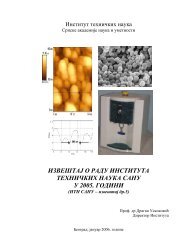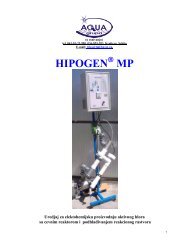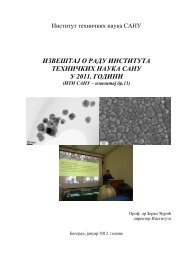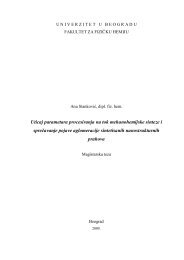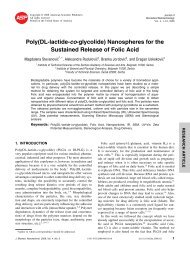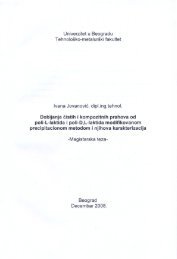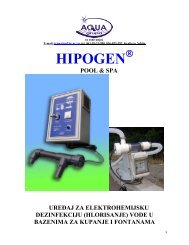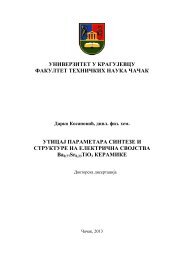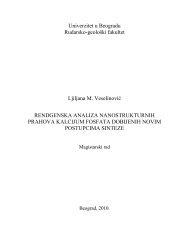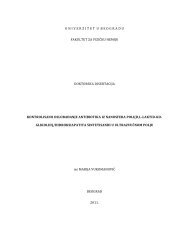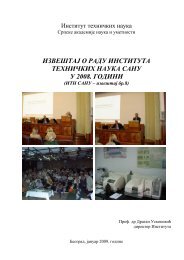Program and the Book of Abstracts (PDF) - Mrs-serbia.org.rs
Program and the Book of Abstracts (PDF) - Mrs-serbia.org.rs
Program and the Book of Abstracts (PDF) - Mrs-serbia.org.rs
Create successful ePaper yourself
Turn your PDF publications into a flip-book with our unique Google optimized e-Paper software.
Tenth Young Researche<strong>rs</strong> Conference – Materials Science <strong>and</strong> Engineering<br />
December 21-23, 2011, Hall 2, SASA, Knez Mihailova 35 & 36, Belgrade, Serbia<br />
I/1<br />
Design, syn<strong>the</strong>sis <strong>and</strong> evaluation <strong>of</strong> non-urea inhibito<strong>rs</strong><br />
<strong>of</strong> soluble epoxide hydrolase<br />
Stevan Pecic 1 , Shi-Xian Deng 1 , Christophe Morisseau 2 ,<br />
Bruce D. Hammock 2 , Donald W. L<strong>and</strong>ry 1<br />
1 Department <strong>of</strong> Medicine, Columbia Unive<strong>rs</strong>ity, New York, NY, USA,<br />
2 Department <strong>of</strong> Entomology <strong>and</strong> UCD Cancer Center, Unive<strong>rs</strong>ity <strong>of</strong> California, Davis, CA, USA<br />
Inhibition <strong>of</strong> soluble epoxide hydrolase (sEH) has been proposed as a new pharmaceutical<br />
approach for treating hypertension <strong>and</strong> vascular inflammation. The most potent sEH inhibito<strong>rs</strong><br />
reported in literature to date are urea derivatives. However, <strong>the</strong>se compounds have limited<br />
pharmacokinetic pr<strong>of</strong>iles. We investigated non-urea amide derivatives as sEH inhibito<strong>rs</strong> <strong>and</strong><br />
identified a potent human sEH inhibitor having potency comparable to urea-based inhibito<strong>rs</strong>.<br />
I/2<br />
Syn<strong>the</strong>sis, characterization <strong>and</strong> sintering properties <strong>of</strong> Zr-doped hydroxyapatite<br />
Miodrag J. Lukić 1 , Srečo D. Škapin 2 , Smilja Marković 1 , Dragan Uskoković 1<br />
1 Center for Fine Particles Processing <strong>and</strong> Nanotechnologies, Institute <strong>of</strong> Technical Sciences <strong>of</strong><br />
SASA, Belgrade, Serbia, 2 Advanced Materials Department, Jožef Stefan Institute, Ljubljana,<br />
Slovenia<br />
Improving <strong>of</strong> material characteristics could be achieved in different ways, but it is always<br />
connected with <strong>the</strong> issue <strong>of</strong> impairing <strong>the</strong> o<strong>the</strong>r functional properties. Hydroxyapatite bioceramics<br />
lacks <strong>of</strong> insufficient mechanical properties for load-bearing implant applications. Nowadays,<br />
making <strong>of</strong> composites, nanostructuring <strong>and</strong> doping <strong>of</strong> basic material are some <strong>of</strong> <strong>the</strong> promising<br />
pathways for hydroxyapatite toughening.<br />
Until now, Zr is not considered as fortifying dopant in hydroxyapatite based materials. However,<br />
it could be interesting in <strong>the</strong> sense <strong>of</strong> nontoxicity, preserved biocompatibility <strong>and</strong> incorporation in<br />
hydroxyapatite crystal lattice since it possesses lower crystalographic radius.<br />
In this study, preliminary experiments <strong>of</strong> chemical precipitation are performed to obtain<br />
hydroxyapatite with various Zr content. The crystal phase composition, particle size <strong>and</strong><br />
morphology changes compared to pure hydroxyapatite are studied. Sintering is performed to find<br />
appropriate conditions for fabrication <strong>of</strong> dense material. Vicke<strong>rs</strong> hardness <strong>and</strong> fracture toughness<br />
were also measured.<br />
1





